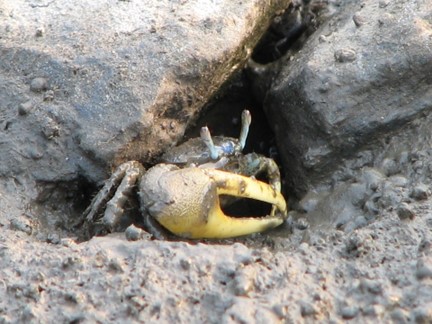CHAPTERS
Navigate to chapter
► Chapter One: Understanding Fiddler Crabs
► Chapter Three: The Life Cycle of a Fiddler
► Chapter Four: Common Modern Day Stressors
► Chapter Five: To Catch or to Buy?
► Chapter Six: Habitat and Maintenance for Fiddler Crabs
► Chapter Seven: Common Sub – Species of Fiddler Crabs
► Chapter Eight: Distribution and Ecology Status
► Chapter Nine: Challenges of the Species
► Chapter Ten: Summary and Care Sheet
Chapter Three: The Life Cycle of a Fiddler

The Fiddler Crab is a little creature that is found along swamps, bogs and marshlands. At least these are the areas where fiddler crabs sold in pet stores come from. Fiddler crabs are also found along coastlines of beaches. As of 2007, the count of fiddler crab specie and sub-specie has been tallied up to a whopping 97 recognized sorts. It is known to have a life span of 2 years in the wild and can thrive up to about 3 years in captivity.
There have even been reports of fiddler caregivers of their fiddler living up to a ripe age of 7 years old and still thriving. So the lifespan of this little guy is all a matter of how the fiddler crab is taken care of to live to its utmost.
A largely diurnal specie, these little crabs are seen to be busiest during daylight and even more active during low tide, when they are able to forage for the sustenance they so need to thrive healthily. They are an active group of crabs that live amongst themselves but have independent burrows. These groups of crabs are constantly working at something, whether it be feeding, cleaning up, fighting for territory, waving at each other (most especially females), fighting off each other and getting burrows ready. They occur in large numbers and are usually seen together foraging for food.
The breeding season for fiddler crabs happens each month. The female spends two week of incubation and another two weeks feeding itself. Mature male fiddler crabs are constantly ready for mating action, and so it is really a competition of sorts when the males attempt to woo female fiddler crabs.
It is typical to witness male fiddler crabs fighting over territory as well as the attention and affections of a female. Although it is unusual to see males and females fight, it can sometimes happen. Females of most species have displayed inherent preferences for the mate they choose. In the wild, the mating process and mate selection of the female fiddler crab is a complex one. It is easier to pair off a male and a female fiddler crab under controlled conditions. Not so much in their natural habitat, though.
There are a number of hindrances which may prevent the female from expressing their choice on the male they mate with. Some are constrained, leaving them little choice on who to mate with. Other times, the risk of being eaten by a predator restricts them from venturing out of their own burrows in search of a suitable male candidate. There are also many cases of females refusing the male due to the substandard build of burrows.
Keep in mind that, burrows are where females stay to incubate their eggs before releasing their eggs to the deep blue, so it is important that the female feels and sees the sturdy construction of a place where they can incubate their eggs in peace away from predators and danger.
Once the female is fertilized, the fiddler crab can be laden with hundreds, even thousands, of eggs that sit in the abdomen of the crab. At this stage, the female fiddler crab is given the nickname sponge crab. Once the eggs are ready to hatch, the female fiddler enters the water to release microscopic larvae. At this stage of the early life of the fiddler crab, the larvae are called zoeae.
The larva goes on to live, swim and feed in the open water as plankton. The zoeae undergo a rudimentary process of molting and shedding their outer suits only to develop a new, sturdier exterior. The older fiddler larva is called a megalopa. It is during this final stage of the post-larvae fiddler when they molt into juvenile crabs. The amount time spent on from the larvae stage to the immature crab stage is different for the species in general.
It typically takes a few weeks to a few months for the crabs to get big enough to find the shoreline. Both the male and female juvenile fiddler crabs look alike at this young stage of their lives. As they grow larger in size, the distinct sexual features of the male from the female become more apparent as the male’s claw grows in size. Once the fiddler crabs come into full maturity, the crabs start courting practices, begin to mate again and the cycle continues.
Animal communication is nature’s way for animals to accurately get across true information. There are, however, some individuals of particular specie that would give deceptive signals that give wrong information. It is believed that these signals that cheat of the correct information is used to entice mates or ward of competition. It is believed these incorrect signals are used when the particular animal wouldn’t be able to do if it were to signal truthfully. It has been noted that some species of fiddler crabs signal deceptively.
When a fiddler crab autotomized their large claw, that is when they shed off this large clawed limb, they are able to regenerate the limb through a process of molting and grow a new one. The new claw usually grows on the opposite side of where the crab lost the claw. In most times, fiddlers can regenerate a new claw that is identical to the one it lost. However, in others, the new claw that the fiddler has regenerated can appear very different from the original claw that was lost.
The newly regenerated claw is notably lacking teeth, it is smaller and more delicate than the one it had initially grown into from when it was growing. Although male fiddler crabs are able to regenerate a new claw with generally the same length as the lost one, the smaller claw lacks in power and muscle mass making it a less effective weapon. However, on the other hand, the less heavy, newly generated claw is lighter to lift thereby making it a better tool for waving at females. Although it is less effective as a bluff to fight with, it may be that males prefer the lighter version of the new limb because it does seem to attract the ladies more.
When a fiddler crab feels there is a threat to its territory, it uses its massive claw to fight off would be over takers. The male fiddler would square off with strangers who approach their burrow and fight them for ownership. Fiddler crabs also fight amongst themselves and mark their territorial boundaries.
Fiddler crabs are wearier of strangers than their usual neighbors since the presence of strangers ups the chances of them losing their burrow and giving up their territory than if they were merely warding off their neighbor from encroaching on their piece of land. Losing to a stranger usually would be followed by the fiddler giving up ownership of the burrow whereas losing to a neighbor would equate a reduction in its general territory. But it is interesting to know that disputes amongst neighbors fiddler crabs are not settled through brute force.
The aggression is used as a sort of punishment to give reminder to the encroaching neighbor to not attempt overtaking the usual territory of the fiddler crab.
Continue Reading…
Want to read the entire thing?

